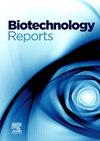Reduction of microbial contamination and biogenic amines formation in Ras cheese using Chlorella vulgaris extracts
Q1 Immunology and Microbiology
引用次数: 0
Abstract
The present study aimed to explore the impact of C. vulgaris aqueous and diethyl ether extracts on reducing microbial contamination and biogenic amines (BAs) formation in Ras cheese during ripening process. Phenolic profile of aqueous extract was quantified by high performance liquid chromatography (HPLC) and compounds in ether extract were determined using gas chromatography-mass spectrometry (GC–MS). Eleven compounds were detected in aqueous extract and catechin was the major (54.82 µg/g), while 14 compounds were detected in ether extract of which the main compounds hexadecane (14.26 %) and 9, 12-Octadecadienoic acid, methyl ester (9.61 %). C. vulgaris aqueous and ether extracts observed antibacterial activity against seven strains of foodborne bacteria with minimum inhibitory concentration (MIC) ranged from 0.33 to 1.43 mg/mL and antifungal activity against 9 strains of toxigenic fungi with MIC values from 0.42 to 1.74 mg/mL. Ras cheese treated with ether extract had the highest reduction in formation of tryptamine (93.4 %), β-phenylethylamine (86.4 %), Putrescine (88.3 %), Cadaverine (81.8 %), Histamine (62.9 %), Serotonin (92.1 %), Tyramine (87.2 %), Spermidine (80.8) and Spermine (86.8 %) compared to cheese treated with aqueous extract and control samples. Also, the microbial load (total bacterial count, yeasts and molds count, proteolytic bacterial count) in Ras cheese samples treated with C. vulgaris aqueous and diethyl ether extracts were lower than the control sample. Whereas, no growth of coliform group, Staphylococci and Salmonella were detected in treated samples and control. The microalga C. vulgaris extracts considered promising source from natural ingredients to reduce biogenic amines content and microbial load in cheese manufacturing.
小球藻提取物减少Ras奶酪中微生物污染和生物胺的形成
本研究旨在探讨寻常草水提物和乙醚提物对Ras奶酪成熟过程中微生物污染和生物胺(BAs)生成的影响。采用高效液相色谱法(HPLC)和气相色谱-质谱联用技术(GC-MS)分别测定水提取物的酚类成分。水提物共检出11种化合物,以儿茶素为主(54.82µg/g);醚提物共检出14种化合物,以十六烷(14.26%)和9,12 -十八烯酸甲酯(9.61%)为主。荆芥水提液和醚提液对7株食源性细菌的抑菌活性在0.33 ~ 1.43 mg/mL之间,对9株产毒真菌的抑菌活性在0.42 ~ 1.74 mg/mL之间。与水提取物和对照样品相比,乙醚提取物处理的Ras奶酪中色胺(93.4%)、β-苯乙胺(86.4%)、腐胺(88.3%)、尸胺(81.8%)、组胺(62.9%)、血清素(92.1%)、酪胺(87.2%)、亚精胺(80.8%)和精胺(86.8%)的含量减少最多。同时,经凡草水提液和乙醚提取液处理的Ras奶酪样品的微生物负荷(细菌总数、酵母菌和霉菌数量、蛋白水解细菌数量)均低于对照样品。处理后的样品和对照组未检测到大肠菌群、葡萄球菌和沙门氏菌的生长。从天然原料中提取的普通微藻提取物被认为是减少奶酪生产中生物胺含量和微生物负荷的有前途的原料。
本文章由计算机程序翻译,如有差异,请以英文原文为准。
求助全文
约1分钟内获得全文
求助全文
来源期刊

Biotechnology Reports
Immunology and Microbiology-Applied Microbiology and Biotechnology
CiteScore
15.80
自引率
0.00%
发文量
79
审稿时长
55 days
期刊介绍:
Biotechnology Reports covers all aspects of Biotechnology particularly those reports that are useful and informative and that will be of value to other researchers in related fields. Biotechnology Reports loves ground breaking science, but will also accept good science that can be of use to the biotechnology community. The journal maintains a high quality peer review where submissions are considered on the basis of scientific validity and technical quality. Acceptable paper types are research articles (short or full communications), methods, mini-reviews, and commentaries in the following areas: Healthcare and pharmaceutical biotechnology Agricultural and food biotechnology Environmental biotechnology Molecular biology, cell and tissue engineering and synthetic biology Industrial biotechnology, biofuels and bioenergy Nanobiotechnology Bioinformatics & systems biology New processes and products in biotechnology, bioprocess engineering.
 求助内容:
求助内容: 应助结果提醒方式:
应助结果提醒方式:


